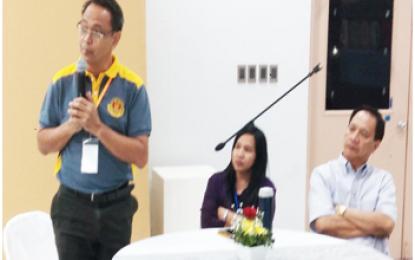
NEW SOFTWARE. Dr. Nathaniel Bantayan, professor at the Forest Resources Management Institute of Renewable Natural Resources, College of Forestry and Natural Resources at University of the Philippines in Los Baños (UPLB) explains the open software “Quantum GIS (Geographic Information System)” which can promote site suitability identification for the establishment of rubber and cacao plantations, during the Philippine Council for Agriculture, Aquatic and Natural Resources Research and Development (PCAARRD) forum in Los Baños, Laguna on March 26, 2018. (Photo by Zen Trinidad)
LOS BAÑOS, Laguna -- A University of the Philippines at Los Baños (UPLB) professor has developed a computer-assisted information system that promotes site suitability identification for the establishment of rubber and cacao plantations in the country.
Dr. Nathaniel C. Bantayan, professor at the Forest Resources Management Institute of Renewable Natural Resources, College of Forestry and Natural Resources, University of the Philippines Los Baños (UPLB), said Monday using open software called Quantum GIS (Geographic Information System) can promote site suitability identification for the establishment of rubber and cacao plantation.
The software was the result of a two-year study with his team of researchers titled “GIS-based Inventory and Sustainability for Rubber and Cacao in Major Production Areas of the Philippines,” which was presented to the media at the Philippine Council for Agriculture, Aquatic and Natural Resources Research and Development (PCAARRD) of the Department of Science and Technology (DOST).
Site suitability, he said, could be assessed by various characteristics such as rainfall, temperature, slope, elevation, land cover and soils using the software.
Funded by DOST-PCAARRD, Bantayan’s study focused more on the establishment of a national database where the existing plantations and productions of rubber and cacao are located mostly in Mindanao and Palawan and the identification of possible areas of expansion.
The study showed that Compostela Valley recorded 29.8 percent of the area that has high potential for planting rubber followed by North Cotabato with 20.8 percent and Zamboanga Sibugay which currently has 68,484 hectares of plantation, making it the largest area planted with rubber followed by North Cotabato with 59,387 hectares.
For cacao plantation, Basilan recorded 10.7 percent of the area that has high potential for planting followed by Davao Oriental with 10.1 percent. At present, Davao Oriental has the largest land area planted with cacao with 6,920 hectares followed by Compostela Valley with 5,879 hectares.
However, Bantayan noted that there is an increasing trend and interest in rubber and cacao planting in Regions 2 and 4-A attributed to the presence of international market that also provides technical assistance and the membership to cooperative encouraging farmers to plant both commodities.
“But in provinces that exhibit moderate or low suitability to a commodity, plantations can give profitable harvest with proper management,” he stressed.
He also observed that some farmers are shifting to planting rubber intercropped with cacao and other high-value crops from corn since there is less investment cost in growing rubber and cacao after planting except labor in harvesting the sap from rubber or fruits from cacao.
“In terms of environmental protection planting rubber offers an advantage as it just grows taking the sap as raw materials for commercial uses,” he explained citing rubber’s other uses as shade for the cacao and other crops.
He recommended support from local government units (LGUs) in areas with high suitability before the establishment of plantations coupled with continuous training and further consultation for the refinement of the parameters for habitat suitability modeling which can be applied to other areas and other commodities.
The recommendations were supported by Dr. Melvin Carlos, deputy executive director for Agricultural Research Management Support Services (ARMSS) of DOST-PCAARRD for sustainability of the research projects of the agency.
“Our research projects run for two to three years and in order to sustain them like any community-based projects, we need the cooperation of the LGUs and barangay officials including training as part of technology transfer,” he clarified. (PNA)
